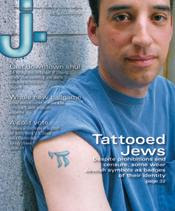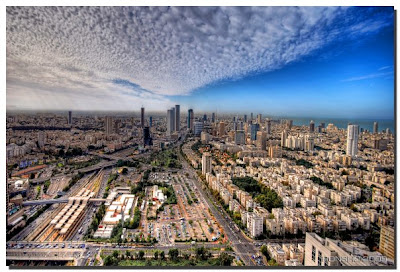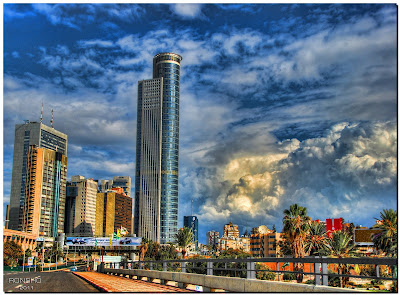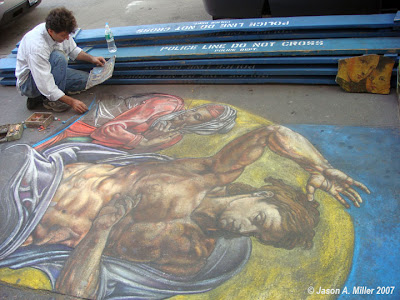Category: Art
After seeing David Craffey‘s creative photo going around Facebook of a little girl writing her alphabet on a chalkboard in which she writes the ‘D’ as the Olde English ‘D’ of the Detroit Tigers logo, I decided to create the Hebrew School version of the photo in which the Hebrew letter dalet becomes the iconic Detroit Tigers ‘D’. Here’s my attempt:
 |
| Inspired by David Craffey Design |
Go Tigers!
Cross-posted to the Jewish Techs blog at The NY Jewish Week
Yesterday’s news was focused on photo editing. A national conversation on the ethics of doctoring photos was kicked off when a Brooklyn-based Hasidic Yiddish language newspaper used Photoshop to airbrush out two prominent women — Hillary Clinton and Audrey Tomason — from an iconic photo released by the White House. More than a rant on the extremes to which the ultra-Orthodox will go to keep photos of women from the pages of their newspapers, what I find most interesting is the question of when it is appropriate to alter a photograph.
But rather than presenting all the instances when one might alter a photograph and arguing that there are times when it’s acceptable to touch up a photo without misrepresenting the historical record, I thought that in honor of Israel Independence day I would focus on one artist who alters photos to create beautiful art that pays tribute to Israel’s cosmopolitan city of Tel Aviv.
Israeli artist Ron Shoshani produces images of Tel Aviv and other contemporary scenes from Israel using the latest technology. Producing such photographs in the past with the use of high-end filters and processing was too expensive, he says. Today, Shoshani is able to create digital photo manipulations in just minutes by applying different post-production filters to his images.
After shooting between 500-700 photographs at each location with an array of different angles, Shoshani then experiments with different lighting and filtering effects that can be applied to all the photographs through batch filer processing. A technique that once took days now only takes him a couple hours.
The artist developed a unique process that consists of a mix of stand alone digital manipulation tools, commercial digital retouch applications and layered textures that have created a unique “signature” of his works that is being recognized around the world.
When I asked Shoshani why he chose Tel Aviv as the subject of most of his photography he gave me two answers. First, he explained, “My family, as pioneers, came to Tel Aviv around 100 years ago and established their life and business in the city. I was born and raised in Tel Aviv as well, and although I was traveling around the world a lot, as a Jew, Tel Aviv is where my heart is. I love the city… this is the ‘Big Apple’ of every Jewish person.” He also has chosen Tel-Aviv as the main focus of his photography as an effort to create iconic photos of the city and to present Tel Aviv like every other international, modern and cosmopolitan city.
Known on the Web as “Ronsho,” Shoshani’s photo collection has been receiving much attention. His photos are displayed and available for sale throughout the Web at such sites as Flickr and Red Bubble. He’s frequently asked to have his photos represent Israel in the media and Time Out Tel Aviv magazine used one of his Tel Aviv skyline photos for its cover story about Tel Aviv.
He explains, “When people see the city the way it was presented on the cover of a magazine, it’s a perception change. It contradicts the regular daily news in which they’ve been hearing about Israel. It makes people think ‘I wanna’ be there. I didn’t know that Israel looked like this.’ With this in mind, the strong power of a visual is being translated into a different mindset.”
So, this week when so many are chastising a newspaper for altering a photo in a negative way, let’s recognize Ron Shoshani who is altering photos with artistic talent to represent Israel in the best light (and filter). Happy 63rd year of independence to Israel!
Coming Out as a Rabbi
There are times when rabbis might not be so willing to let others know they’re a rabbi. Apparently that wasn’t the case for Rabbi Geoff Mitelman, a Reform rabbi in Westchester, NY, when he was an audience member of the Daily Show with Jon Stewart. Geoff and I spent a couple of hours learning a piece of text from the Torah together this past November in the Clal offices in NYC as part of the Rabbis Without Borders fellowship. A few weeks later, he posted the following on our group’s e-mail forum:
The reason I’m writing is because I thought you all might get a kick out of this — my girlfriend and I went to the taping of The Daily Show last night. Jon Stewart is actually QUITE Jewish (and is pretty knowledgeable about Judaism), and he does a Q&A with the audience before each show. I (of course) had to see if I could bring out any of his latent Jewish-ness, so I told him I was a rabbi and asked him what his favorite Hanukkah memory was… It was very cool.
Here is the clip from the beginning of the show which aired later that night:
| The Daily Show With Jon Stewart | Mon – Thurs 11p / 10c |
| Intro – Rabbi in the Audience (RabbiJason.com) |
|
| www.thedailyshow.com | |
Not all rabbis, however, would be so forthcoming about their profession (especially to a man about to broadcast to millions of people). In fact, Rabbi Mitelman’s posting led to an interesting conversation about when to fess up about being a rabbi and when to keep the cards closer to the chest. One female Conservative rabbi married to a male Reform rabbi explained that they had also been to a taping of the Daily Show with Jon Stewart a week prior, but chose to not disclose their professions.
She wrote that there are times when she has “not shared that I was a rabbi in order to avoid the inevitable shock, surprise, and ensuing questions. Usually when I am traveling, on vacation, or otherwise outside of my “normal” world, I do not advertise the fact that I am a rabbi, and have often responded that I was a teacher or social worker when directly asked my profession. I am now wondering if I am doing myself and our profession a disservice by doing this. Would it be breaking down more borders and opening up new opportunities to share my profession?”
There are certainly times when it makes sense for rabbis not to broadcast what they do. This would be more difficult for the Catholic priest who’s collar is a dead give-a-away. I know of rabbis who go grocery shopping many miles from their home so as to experience some privacy. There are also rabbis who wouldn’t think of exercising at the local Jewish Community Center for fear of being bothered with work-related questions. Personally, I enjoy working out at the JCC and find that most people are quite respectful of the reason that I’m there (to break a sweat and not play “Ask the Rabbi”).
For some rabbis, the setting might dictate whether they “out” themselves as a rabbi or not. Seated next to a fellow Jewish person on an airplane, for instance, if I say I’m a rabbi I could be in for a long flight listening to every reason why Hebrew School was a scarring experience for this individual. Why their childhood rabbi caused them to despise organized religion in general as an adult. Seated next to a non-Jewish individual on an airplane, I could explain that I’m a rabbi and then field endless questions about why Israel doesn’t just make peace with her Arab neighbors already, or why some Haredi rabbi was indicted for tax fraud. That would be like a Unitarian minister having to defend Catholic priests for the child molestation scandal.
 This is the reason why Rabbi Joel Meyers, former executive vice-president of the Rabbinical Assembly, admitted to his colleagues at a convention in 2007 that he often tells the person sitting next to him on the plane that he is either a college professor or a therapist.
This is the reason why Rabbi Joel Meyers, former executive vice-president of the Rabbinical Assembly, admitted to his colleagues at a convention in 2007 that he often tells the person sitting next to him on the plane that he is either a college professor or a therapist.
Ultimately, however, I recognize that I am always a rabbi. There have been times when I’ll tell someone that I am a rabbi and it leads to a wonderful and fulfilling experience. The opportunity to teach strangers (both Jews and non-Jews) often arises at the least likely times. I’m sure it’s no different than my friend who’s a pediatrician not wanting to volunteer her profession when she’s on an airplane for fear that she’ll have to give medical advice for every ailment that has ever afflicted the children of the woman seated next to her. But in the event of a child getting sick on the plane, I know she’d jump into action without a moment’s hesitation.
Last month, I was on an airplane returning home from New York. A Jewish man sat down next me. (I know he was Jewish because as soon as he saw I was wearing a kippah, he immediately told me that he’s Jewish and that he speaks a little Yiddish.) He spent the entire plane ride telling me about what he did for a living. And it was truly fascinating.
 The man, Walter Arnold (pictured), is an extremely talented artist who works with stone. He’s designed beautiful fireplaces, breezeways, fountains, and sculptures for some of the most breathtaking homes and churches in the country. Trained in Italy, Walter told me that his art graces the White House, Washington National Cathedral, and the Capitol. He pulled out his computer and showed me dozens of pictures of his work. It was breathtaking.
The man, Walter Arnold (pictured), is an extremely talented artist who works with stone. He’s designed beautiful fireplaces, breezeways, fountains, and sculptures for some of the most breathtaking homes and churches in the country. Trained in Italy, Walter told me that his art graces the White House, Washington National Cathedral, and the Capitol. He pulled out his computer and showed me dozens of pictures of his work. It was breathtaking.
At the end of the flight, Walter handed me his business card and asked for mine in return. Looking at it, he exclaimed, “Wait, you didn’t tell me you were a rabbi. I could have asked you so many questions.” I explained to him that what he does for a living is much more interesting to me than what I do. I thanked him for the enjoyable conversation. And we said goodbye.
Irving Berg
When I was an 11-year-old camper at Camp Maas in Ortonville, Michigan, I had the privilege to be part of the group of campers in Deroy village who designed and built a concrete sculpture. “Priestly Blessing” is an artistic representation of the hands of the kohen (priest) offering his blessing. The artist who led the project was Irving Berg (right), the long-time artist-in-residence of Tamarack Camps.
Irving Berg died on March 21, 2009 at 87. It is impossible to walk around the Tamarack property (1,500 acres) without encountering his sculptures. The Irving Berg Sculpture Garden is one man’s permanent contribution to a Jewish camp. With these sculptures Irv will continue to educate Jewish campers about their heritage even after he no longer walks this earth.
 This past summer (2008), I facilitated a scavenger hunt of sorts with the oldest campers at Camp Maas — the Teen Service Staff (TSS). The group of sixty teens who would be entering 11th grade were divided into smaller groups and then sent out in search of some of Irv Berg’s sculptures. They had to decipher the Jewish message each sculpture represents and then report back to the group. Many of the Jewish teens remarked how they had spent many summers at camp seeing these works of art, but never considered the deeper meaning behind each sculpture.
This past summer (2008), I facilitated a scavenger hunt of sorts with the oldest campers at Camp Maas — the Teen Service Staff (TSS). The group of sixty teens who would be entering 11th grade were divided into smaller groups and then sent out in search of some of Irv Berg’s sculptures. They had to decipher the Jewish message each sculpture represents and then report back to the group. Many of the Jewish teens remarked how they had spent many summers at camp seeing these works of art, but never considered the deeper meaning behind each sculpture.
A wonderful tribute to Irv’s legacy at camp was created in Summer 2008. Award-winning animator Gary Schwartz created an animated documentary of Irv Berg’s sculptures. The film can be viewed below.
As the rabbi of Tamarack Camps, I had the distinct honor of officiating at Irv Berg’s funeral. The hesped (eulogy) that I delivered is available online and the obituary is available at the Detroit Jewish News website.
Tattoo Jew
The five week hiatus since my last blog post might be the longest dry spot I’ve had since starting this blog almost five years ago.
 But I have a good excuse — I’ve been working at Camp Tamarack all summer. As the camp rabbi I’ve fielded many questions, but by far the most common question I’ve received from counselors has been “the tattoo question.”
But I have a good excuse — I’ve been working at Camp Tamarack all summer. As the camp rabbi I’ve fielded many questions, but by far the most common question I’ve received from counselors has been “the tattoo question.”
Everyone wants to know if they will still be buried in a Jewish cemetery even though they have a tattoo. It’s remarkable how concerned twenty-year-olds are about an event far into the future that they won’t even be around to witness.
The sentiment that Jews with body art are barred from Jewish cemeteries has also been mentioned recently in a movie, a TV show, and in the mainstream media.
In the wonderful film “The Bucket List,” two cancer-stricken men, Carter (Morgan Freeman) and Edward (Jack Nicholson), plan to do some outrageous things before they “kick the bucket.” When Morgan Freeman’s character is somewhat hesitant about getting a tattoo, Jack Nicholson as Edward says to him: “What, are you afraid of not being able to be buried in a Jewish Cemetery?”
In an episode of “Curb Your Enthusiasm,” Larry David pays off a gravedigger to have his mother reburied in a Jewish cemetery despite a small tattoo on her rear end.
 And in the July 17th New York Times, the article titled “Hey Mom, the Rabbi Approved my Tattoo” (subtitled “Skin Deep: For Some Jews, It Only Sounds Like ‘Taboo’) also takes on the belief that Tattooed Jews can’t be buried in a Jewish cemetery.
And in the July 17th New York Times, the article titled “Hey Mom, the Rabbi Approved my Tattoo” (subtitled “Skin Deep: For Some Jews, It Only Sounds Like ‘Taboo’) also takes on the belief that Tattooed Jews can’t be buried in a Jewish cemetery.
By the time [Roberta] Kaplan’s daughter Liz Carnes, 49, had teenage daughters who wanted body art, Ms. Carnes knew how to dissuade them. “I’d say, ‘If you get a tattoo, you can’t be buried in a Jewish cemetery,’ ” said Ms. Carnes, the owner of a video equipment company in Carlsbad, Calif. “For no real reason, just that’s what my parents told me.”
Nearly every Jew, from those who go to synagogue only on holidays to those who dutifully follow Jewish law, has heard that adage. It has deterred many from being inked, even as tattoos have become widespread among N.B.A. players and housewives alike.
It seems that most young people are familiar with this warning about getting a tattoo. The only problem is that it is a myth! Thankfully, the NY Times article calls it an “urban legend.”
But the edict isn’t true. The eight rabbinical scholars interviewed for this article, from institutions like the Jewish Theological Seminary and Yeshiva University, said it’s an urban legend, most likely started because a specific cemetery had a policy against tattoos. Jewish parents and grandparents picked up on it and over time, their distaste for tattoos was presented as scriptural doctrine.
Rabbi Alan Lucas, in a 1997 teshuvah for the Conservative Movement’s Law Committee, took up the issue of body piercing and tattooing in Jewish law. The question he posed was: “Is body piercing (nose, navel, etc.) and tattooing permitted? Does it preclude taking part in synagogue rituals or being buried in a Jewish cemetery?”
He explains that the prohibition of tattooing is found in the Torah in Leviticus 19:28 where it states: You shall not make gashes in your flesh for the dead, nor incise any marks on yourselves: I am the Lord.
The mishnah explains that it is the lasting and permanent nature of tattooing which makes it a culpable act, but Rabbi Simeon disagrees and says that it is only the inclusion of God’s name which makes tattooing prohibited. Maimonides felt that tattooing should be prohibited because it was a form of idolatry since the pagans would tattoo themselves.
Rabbi Lucas maintains that:
Regardless of the exact limits of this prohibition, over time, the Rabbis clearly extended the prohibition to include all tattooing… In our day, the prohibition against all forms of tattooing regardless of their intent should be maintained. In addition to the fact that Judaism has a long history of distaste for tattoos, tattooing becomes even more distasteful when confronted with a contemporary secular society that is constantly challenging the Jewish concept that we are created b’tzelem Elohim, “In the Image of God,” and that our bodies are to be viewed as a precious gift on loan from God, to be entrusted into our care and not our personal property to do with as we choose. Voluntary tattooing even if not done for idolatrous purposes expresses a negation of this fundamental Jewish perspective.
Rabbi Lucas concludes that Tattooing is an explicit prohibition from the Torah, however, those who violate this may still be buried in a Jewish cemetery and participate fully in all synagogue ritual.
It seems to me that if a Jewish person chooses to get a tattoo that is in good taste and does not violate the Torah prohibitions of idol worship, then this act would not violate Jewish law since in our modern age tattoos can be removed (even if removal is a painful process and one that might need to be repeated several times). A tattoo that expresses ones Jewish pride is certainly not what the Rabbis of the Talmud had in mind when they discussed the tattooing practices of the pagans. And with regard to the “Auschwitz argument” against tattoos: body art in the 21st century certainly does not resemble the forced tattooing of Jewish men and women during the Holocaust.
Sidewalk Art in NYC
This is my 500th post on the RabbiJason.com blog!
Rather than write anything substantial, I thought I would just post a photo I took last week in New York City. Walking down Broadway on the Upper West Side of Manhattan, I saw this artist drawing in chalk on the sidewalk. I couldn’t resist watching him work for about ten minutes. Very impressive!
Paintjam by Dan Dunn
This is very cool. Make sure you watch it until the end.



